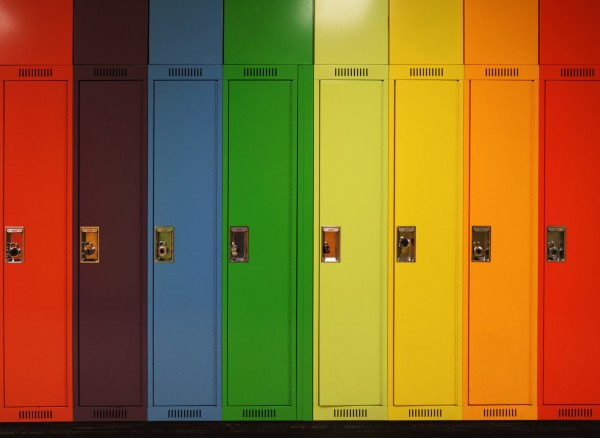By Elizabeth Gartley
When I speak to educators about LGBTQ issues, they typically have an easier time accepting different sexual orientations than gender diversity. Most of these educators are well-meaning, and they’re not unaccepting of transgender or gender nonconforming students, but rather a little perplexed at having to challenge their own notions of gender. In one workshop, a high school teacher shared that in one class she had a student who identified as agender, and this teacher had to rethink addressing the class as “Ladies and gentlemen.” Later, another teacher asked me privately if this was really necessary. After all, she reasoned, how often would we actually have an agender or otherwise gender nonconforming in our classes? Did we really need to change our use of relatively benign language like “boys and girls” or “ladies and gentlemen?”
I have to admit that my thinking was once similar (I’m cisgender). I wasn’t unwilling to be supportive of transgender or gender nonconforming students, but I thought the population was so small that I didn’t need to think about it. But, a few years ago I learned that of my graduating class of 84 students, at least three people have since come out as transgender. This knowledge was one factor in helping me change the way I thought about gender in schools. More broadly, as transgender and gender nonconforming people gain more visibility in our society, the more they need allies and real support.
Earlier this month, the Huffington Post reported that 29 bills had been filed in state legislatures to prevent transgender people from using the bathroom or locker room of their gender. Gov. Dennis Daugaard of South Dakota vetoed one such bill that specifically targeted transgender students in public schools, and the House of Representatives ultimately failed to override that veto. Tennessee Governor Bill Haslam is concerned that if passed, a similar bill, which would not allow transgender students to use the bathroom which corresponds with their gender identity, could lead to public schools in the state losing federal funding. Gov. Haslam’s concerns stem from Title IX, a 1972 federal law which prohibits discrimination based on sex, and under the Obama administration, the Department of Education announced in April 2014 that Title IX also protects transgender students from discrimination.
Unsurprisingly, transgender students can face even harsher school experiences than their cisgender gay, lesbian, and bisexual peers. According to Harsh Realities, a 2009 report from GLSEN, “about two-thirds (65%) of transgender students felt unsafe because of how they expressed their gender (i.e., a student who does not express themselves in a way considered to be appropriately “masculine” or “feminine” according to traditional societal norms).” The good news is that providing transgender and gender nonconforming students with a supportive and inclusive environment can make a positive difference in those students’ lives.
In recent years, several LGBTQ organizations have published guides specifically for K-12 schools on best practices for serving transgender and gender nonconforming students, including the Massachusetts Transgender Political Coalition’s Best Practices for Serving Transgender and Gender Non-Conforming Students in Schools and Schools In Transition: A Guide for Supporting Transgender Students in K-12 Schools a joint effort by the ACLU, Gender Spectrum, the Human Rights Campaign, the National Center for Lesbian Rights, and the National Education Association. These guides cover policy guidelines regarding official records and names and pronouns, restroom and locker room accessibility, bullying and harassment policies, athletics, and dress codes. While such policy considerations are important, school librarians and educators can also offer everyday support and inclusion.
Trans Student Educational Resources (TSER) suggests that on the first day of school, teachers ask students for their preferred name. This gives transgender (and other) students an opportunity to share the name that makes them comfortable without being singled out. TSER also suggests teachers avoid separating students into gender groups. Growing up, I had a classmate and friend I’ll call Alex, who was designated female at birth, but even by second grade, us kids could recognize that Alex was not a girl. When teachers had us group up into boys and girls, it wasn’t just uncomfortable for Alex, but it was uncomfortable for the rest of us too. We saw our friend forced into a category that we, as seven year-olds, could see didn’t fit. The National Center for Transgender Equality and GLSEN also have helpful resource pages for serving transgender and gender nonconforming students.
Having an inclusive library collection benefits all students (I mentioned last month that I had several students who were enjoying the book Beyond Magenta: Transgender Teens Speak Out by Susan Kuklin). Since I’m cisgender myself, I can’t always read trans-inclusive texts with as critical an eye as I would like, so I seek out reviews by trans readers. In particular, I’ve become fond of Gay YA and the Gay YA blog and the trans tag. Overall, I’ve been happy to see that the number of children’s and young adult books featuring transgender and gender nonconforming characters and protagonists has increased in recent years. I’ve been even happier to see that the number of those books by transgender and gender nonconforming authors is also increasing, including picture books like George by Alex Gino and I Am Jazz by Jessica Herthel and Jazz Jenning, and young adult novels like Lizard Radio by Pat Schmatz and The Unintentional Time Traveler by Everett Maroon.

